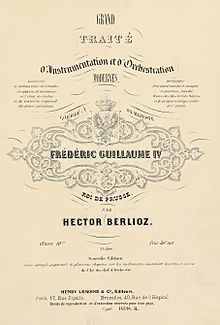
Grand traité d’instrumentation et d’orchestration modernes, abbreviated in English as the Treatise on Instrumentation (sometimes Treatise on Orchestration) is a technical study of Western musical instruments written by Hector Berlioz. It was first published in 1844 after being serialised in many parts prior to this date and had a chapter added by Berlioz on conducting in 1855.
In 1904, Richard Strauss was asked to update the text to include some modern instruments and added musical examples from Wagner, and in 1905 the updated Treatise with a new preface by Strauss was published in German. The 1905 edition was translated into English in 1948.
The book discusses the various technical aspects of instruments, such as chromatic range, tone quality, and limitations. An explanation of the role of particular instruments within the orchestra is also provided. The book also provides orchestral excerpts from classical scores to give examples of techniques discussed. These examples are sometimes of works by Berlioz himself, while Mozart, Wagner, Beethoven, and Gluck are also frequently cited.
Many composers studied the work closely, such as Modest Mussorgsky, Gustav Mahler, Richard Strauss, and Nikolai Rimsky-Korsakov.
Instruments discussed
The following musical instruments are discussed in the Treatise.
Strings:
Plucked strings:
Keyboards:
Wind instruments:
- Oboe
- Oboe d'amore
- English horn
- Bassoon
- Tenoroon (Bassoon Quinte)
- Clarinets (including Alto and Bass clarinets)
- Basset-horn
- Flute (alto flute)
- Piccolo
- Serpent
- Russian bassoon
Brass instruments:
- French horn
- Valve horn
- Trumpet
- Cornet
- Trombones
- Tubas (bass tuba)
- Bugle
- Keyed bugle
- Valve bugle
- Ophicleide (Bass, Alto, Double-Bass)
- Bombardon
Voices: (Soprano, Alto, Tenor, Bass etc.)
Percussion:
- Timpani (Kettle drums)
- Bells
- Glockenspiel
- Glass harmonica
- Ancient cymbals
- Bass drum
- Gong
- Tambourine
- Side drum
- Tenor drum
- Triangle
- Crescent
New instruments:
- Saxophones
- Saxhorn
- Saxotrombas
- Saxtubas
- Concertina
- Melodium organ
- Octobass
- Pianos and Melodiums with prolonged sounds
Other topics discussed
The orchestra: An overview of how the orchestra functions as a whole and its development throughout history.
On conducting: A brief discussion of conducting practices in Europe during Berlioz's day. Berlioz was also known as a great conductor in his time, in addition to a composer.
References
- Instrumentationslehre, Hector Berlioz and Richard Strauss, CF Peters, Edition Peters 3120, Leipzig 1905
- ^ Treatise on Instrumentation by Hector Berlioz and Richard Strauss, translated by Theodore Front, published by Edwin F. Kalmus, NY, NY 1948
- Note: this refers to new instruments as of ca. 1850.
External links
- Treatise on Instrumentation: Scores at the International Music Score Library Project
- Excerpts from the Treatise on Instrumentation and Orchestration
- Treatise on Instrumentation and Orchestration complete, with additions by Richard Strauss, in English, on IMSLP.org
- Treatise on Instrumentation and Orchestration, English translation of the 1858 Novello edition at Google Books
| Hector Berlioz | |
|---|---|
| Operas | |
| Symphonies and overtures | |
| Liturgical works | |
| Other choral works | |
| Songs and cantatas | |
| Books |
|
| Related |
|